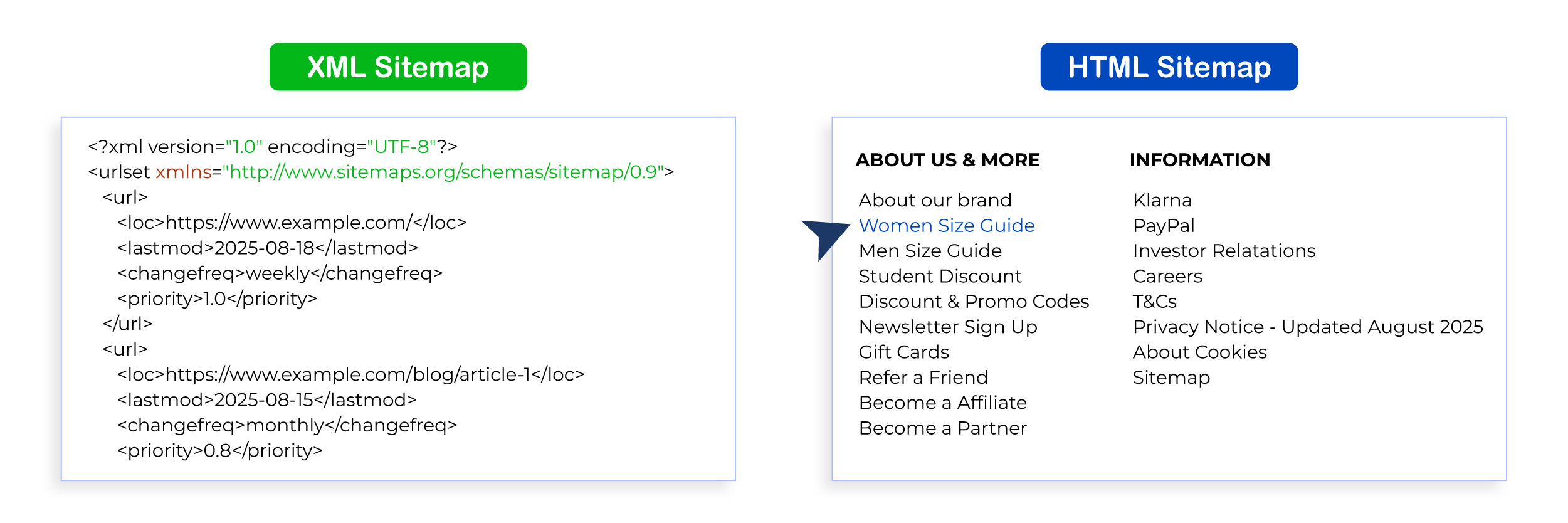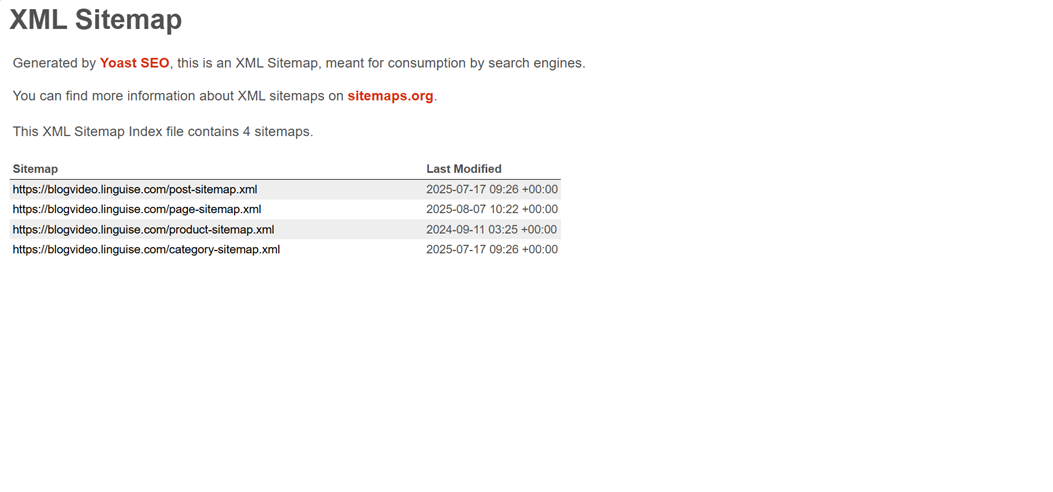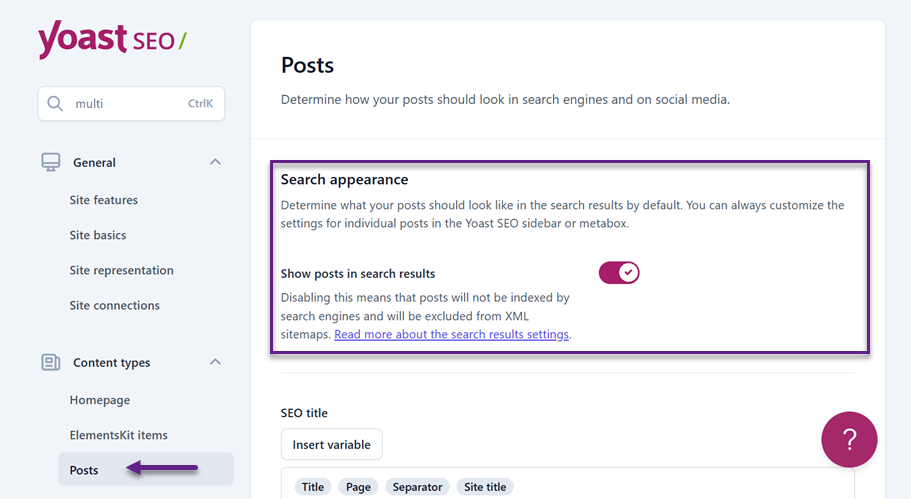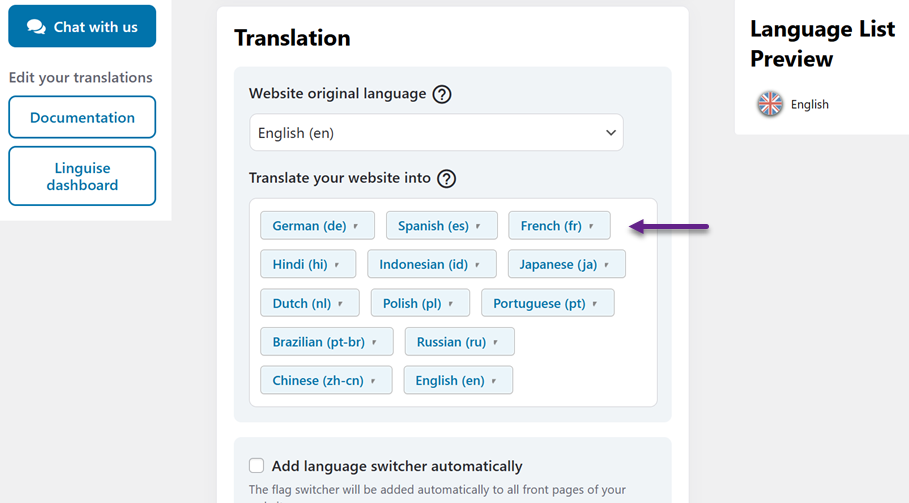Ensuring that all pages of your website are easily discoverable by search engines is crucial. An SEO-optimized XML sitemap helps bots and crawlers navigate every page of your site, increasing the chances of higher rankings and greater visibility.
Translating your sitemap is equally important, as it expands the number of indexed pages across multiple languages. Therefore, understanding how to translate a Yoast SEO XML Sitemap can provide significant advantages in reaching a global audience.
What is an XML sitemap?

To keep it simple, an XML sitemap is basically a file that lists all the important pages of a website. Using an XML sitemap ensures that search engines like Google can find and crawl these pages and understand the structure of your website. So basically, it’s a standardized way of listing website pages and ensuring they can be discovered by search engines. An XML sitemap consists of multiple parts that include:
- XML version declaration – is used by search engine crawlers to determine the type of file they’re reading.
- URL set – provides protocol details to the search engine.
- URL – provides a list of the URLs of the web pages on a website.
- Lastmod – provides the most recent date on which the web page was modified.
When using XML sitemaps, it’s important to understand that it must follow this structure in order for it to be valid. A single XML sitemap can contain up to 50,000 URLs and can have a size of up to 50 MB. However, it’s important to mention that the number of URLs in a sitemap influences crawling speed.
The crawl speed is basically determined by the ratio of:
Your website traffic / The number of page you have. It means that if you have a website with small traffic, you don’t need to submit 50K URLs in your sitemap. Otherwise, your website maybe slowly indexed.
Difference between XML and HTML sitemaps

While both XML and HTML sitemaps serve to organize your website’s content, their purposes differ. XML sitemaps are primarily designed for search engines, helping crawlers discover and index your pages more efficiently. HTML sitemaps, on the other hand, focus on the user experience, providing a clear directory for visitors to navigate your website. Using both types strategically ensures better indexing, improved navigation, and an overall SEO boost.
Feature | XML Sitemap | HTML Sitemap |
Purpose | For search engines and crawlers | For human visitors |
Format | Structured XML file | Web page with a list of links |
Indexing | Helps search engines find all pages quickly | Does not directly affect indexing |
Internal Linking | Limited; mainly for crawler reference | Provides strong internal linking opportunities |
Content Coverage | Can include large number of URLs (up to 50,000 per sitemap) | Typically lists main pages; may not include all URLs |
Best Practices | Keep XML valid and up-to-date; include multilingual URLs for international SEO | Organize logically; make it easy to browse; link to important pages. |
By using XML sitemaps for search engine optimization and HTML sitemaps to guide your visitors, you can create a more discoverable and user-friendly website. Together, they complement each other, ensuring both search engines and users can access your content effectively.
Importance of translated sitemaps for an international website’s SEO

Optimizing your website for multiple languages goes beyond just translating content. Using translated sitemaps ensures that search engines can discover and index all versions of your pages, helping your site reach a wider audience and improve overall SEO performance.
- Enhanced indexing for multilingual pages: Translating sitemaps allows search engines to index every language version of your website. For example, a site with 10 languages and 50 pages could potentially result in 500 indexed pages, significantly increasing your visibility across global search results.
- Improved search engine understanding of website structure: Multilingual sitemaps help search engines grasp the hierarchy and layout of your website. This ensures that crawlers understand the relationships between pages in different languages, reducing the risk of missed content or indexing errors.
- Higher potential rankings and visibility: By making all translated pages accessible to search engines, your website can compete in more search markets. Indexed multilingual pages contribute to better rankings, leading to increased organic traffic and audience growth.
- Support for international SEO strategies: Using translated sitemaps aligns with best practices in international SEO. They complement other strategies like hreflang tags, helping search engines serve the correct language version to users based on location and preferences.
Installing Yoast SEO plugin and activating the sitemap generation

The most effective way of translating a sitemap is to use a plugin. Plugins can be installed on your website’s content management system (CMS) and can be used to generate XML sitemaps. Using the Yoast SEO plugin remains the most preferred option for several reasons.
It assists search engine crawlers by prioritizing the most important pages of your website. In addition, it helps share meta elements allowing search engines to determine when your content was last updated. In addition, using Yoast allows you to control the information included in your sitemap.
Install and activate the Yoast SEO plugin
To install the Yoast SEO Plugin, log in to your website’s CMS. For this tutorial, we will be using WordPress as an example. Once you’ve logged in, click on “Plugins.” When you’ve been redirected to the Plugins page, click “Add New” and then search for the Yoast SEO Plugin. Those who do not have the plugin installed can click on “Activate” to add it to their website’s CMS.

Enable XML sitemap feature
After installing the plugin, open the “Yoast SEO” option located in the navigation panel, then click “Settings”. Once you are in the Yoast SEO settings, type XML sitemaps in the search field.

After that, the screen below will appear. Click enable, then click the “View XML Sitemap” option to continue.

The Yoast SEO plugin will direct you to a web page where all XML sitemap files will be listed.

From here, you can view individual sitemaps for all pages on your website by clicking and opening the corresponding XML file. Let’s take a look at the URL for “page-sitemap.xml” from our example.

Exclude content type from XML sitemap
You can exclude specific content types from your XML sitemap in the “Content Types” section of the Yoast SEO settings. Simply select the content type you want to exclude (for example, posts) and toggle the switch next to “Show posts in search results” to disable it.
Once done, this content will no longer appear in your XML sitemap. This doesn’t mean we recommend excluding your posts or pages entirely from your sitemap. However, it gives you full control over which content types are included, allowing you to tailor your XML sitemap to your SEO strategy.

Translating the Yoast SEO XML sitemap
In addition to viewing your sitemap, you need to include translated posts, pages, and custom post types in your XML sitemap.
With some popular WordPress plugins like Polylang, this process is manual. You usually have to enable translations for the correct custom post types in the plugin settings. Other types of content or specific taxonomies might not be supported, making it difficult to include them.
However, with Linguise automatic translation, you can skip all the manual work. Linguise will automatically translate your XML sitemap. To do this, make sure you have installed the Linguise plugin in WordPress, your API key has been set, and the desired language has been added (for example, French).

To start, click on the XML sitemap file you want to translate. For example, we will use “post-sitemap.xml”. Then, simply add the desired language, for example, /fr/ for French. In this example, adding “fr” to the URL will automatically translate all URLs in “post-sitemap.xml” into French.

Since Linguise translates WordPress website URLs directly rather than by content type, it makes it much easier to include 100% of your content in the translated sitemap.
You can verify this in the Linguise dashboard, where you can also check all your URLs. After accessing your website’s Linguise admin dashboard, click the “Translations” option from the top menu. From the drop-down menu, select “URL Translations.”
Here, you’ll see all the URL translations generated by Linguise. Since Linguise automatically creates all translated URLs, you can effortlessly generate a multilingual sitemap.

Submit multilingual Yoast SEO XML sitemap
After translating the multilingual XML sitemap from Yoast SEO, we will then try to submit it to Google Search Console to to ensure proper multilingual page indexing.
To do this, make sure you have set up Google Search Console for multilingual websites. After that, open the Sitemaps menu, then enter the previously translated sitemap and select Submit.

Then, if successful, a Success status will appear as shown below.

When clicked, it will take you to the sitemap information details, where the sitemap discovers two pages.

Troubleshooting sitemap errors in Google Search Console

When submitting translated XML sitemaps, you might encounter errors or issues in Google Search Console (GSC). Addressing these issues promptly ensures that your pages are properly indexed and visible to international audiences. Below are common errors and how to resolve them.
1. Sitemap not found (404 error)
A 404 error appears when Google cannot locate the sitemap you submitted. This usually happens due to an incorrect URL path, a sitemap that hasn’t been generated yet, or recent changes to your website structure. Without resolving this, search engines will not be able to crawl and index your pages properly.
Solution:
- Verify the sitemap URL by opening it in a browser to confirm accessibility.
- Ensure that the latest Yoast SEO plugin (2025 version) has generated the sitemap correctly.
- Update the sitemap URL in Google Search Console if it has changed after website restructuring or plugin updates.
2. Sitemap parsing error
Parsing errors occur when Google is unable to read your sitemap’s XML structure. This can be caused by invalid characters, incorrect XML syntax, or improperly formatted tags. If not addressed, Google may ignore part or all of your sitemap, affecting the indexing of your pages.
Solution:
- Check that the sitemap uses correct XML formatting with proper <urlset>, <url>, <loc>, and <lastmod> tags.
- Use the updated Yoast SEO 2025 plugin’s sitemap regeneration feature.
- Remove any manually added characters or spaces that could break XML syntax.
3. Pages not indexed
Sometimes, even after Google reads the sitemap, certain pages may not be indexed. This is often the case for multilingual pages or newly added content. Non-indexed pages will not appear in search results, limiting your site’s visibility.
Solution:
- Make sure all translated pages are live, accessible, and not blocked by robots.txt.
- Use Linguise to ensure automatic translation generates proper URLs for your multilingual sitemap.
- Inspect individual URLs in Google Search Console and request indexing for missing pages.
4. Duplicate URLs or canonical issues
Duplicate URLs or incorrect canonical tags can prevent Google from indexing the correct version of your pages. This often happens with multilingual websites where multiple language versions exist for the same content. Failing to address this can lead to SEO penalties and confusion in search results.
Solution:
- Verify that each URL in the sitemap points to a unique page.
- Configure canonical URLs properly using the Yoast SEO plugin (2025 version) for each page.
- For multilingual sites, ensure each language version has a canonical tag pointing to its corresponding language page.
5. Sitemap submission pending or not updated
After submitting a sitemap, Google may show the submission as pending or outdated. This delay can affect how quickly new or updated pages are indexed, which can slow down your site’s visibility in search results.
Solution:
- Re-submit the sitemap in Google Search Console to trigger processing.
- Set the update frequency correctly in Yoast SEO to reflect your website’s content changes.
- Check server responses and ensure that the sitemap is not blocked or restricted by robots.txt or other server settings.
Key takeaways on XML sitemap translation
Investing some time in preparing the XML sitemaps with Yoast then using an automatic translation tool Linguise to generate a multilingual version, will bring you big SEO improvement.
It allows you to create translated sitemaps resulting in more URLs being indexed and the possibility of a higher ranking as your website is growing. Start now and see the benefits of the Linguise automatic translation service.




